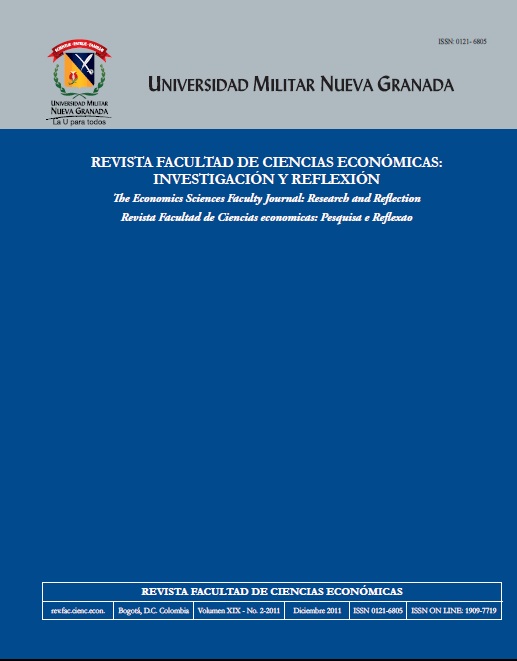Aceitacào do e-commerce na Colombia: um estudo para a cidade de Medellín
Resumo
O e-Commerce é um fenómeno crescente na América Latina e na Colombia. Por isto o estudo da sua aceitagáo tecnológica é de alta importancia académica e empresarial. O objetivo deste artigo é identificar os antecedentes da intengáo de uso de e-Commerce na Colombia. O Modelo de Aceitagáo Tecnológica (TAM) é complementado neste estudo pelos constructos de Confianga e Seguranga Percebida com o fim de propor um modelo adequado ao caso colombiano. Referido modelo é contrastado empiricamente com uma mostra de consumidores da cidade de Medellín. Com isto se evidencia a importancia da confianga e da utilidade percebida como antecedentes diretos da intengáo do uso do e-Commerce, e a facilidade do uso e da seguranga percebida como antecedentes indiretos. Os resultados preenchem vazios existentes na literatura sobre o e-Commerce na Colombia e permitem identificar envolvimentos empresariais relevantes para o desenvolvimento de atividades comerciais através da Internet.Downloads
##plugins.generic.ArticleMetadataByBiteca.languages##:
esReferências
Ajzen, I. (1991) "The Theory of Planned Behavior". En: Organizational Behavior and Human Decision Processes, 50 (2): 179-211.
Ajzen, I. & Fishbein, M. (1977) "Attitude-Behaviour relations: A theoretical analysis and review of empirical research". En: Psychological Bulletin, 84 (5): 888-918.
Ajzen, I. & Gilbert, N. (2008) "Attitudes and the prediction of behavior" En: Crano, W. D. y Prislin R. (Eds.). Attitudes and attitude change. New York: Psychology Press.
Al-Gahtani, S. (2011) "Modeling the electronic transactions acceptance using an extended technology acceptance model". En: Applied Computing and Informatics, 9 (1): 47-77.
Anderson, J. & Gerbing, D (1988) "Structural equation modeling in practice: A review and recommended two-step approach". En: Psychological Bulletin, (103): 411-423.
Bagozzi, R. P. (1992) "The Self-Regulation of attitudes, intentions, and behavior". En: Social Psychology Quarterly, 55 (2): 178-204.
Bagozzi, R. P & Phillips L. W. (1982) "Representing and Testing Organizational Theories: A Holistic Construal". En: Administrative Science Quarterly, 27 (3): 459-489.
Bagozzi, R. P & Yi, Y. (1988) "On the evaluation of structural equation models". En: Journal of Academy of Marketing Science, 16 (1):74-94.
Bignè, E.; Ruiz C. & Sanz S. (2007) "Key Drivers of Mobile Commerce Adoption. An Exploratory Study of Spanish Mobile Users". En: Journal of Theoretical and Applied Electronic Commerce Research, 2 (2): 48.
Bollen, K. A. (1989) Structural equations with latent variables. Mexico: Wiley.
Brynjolfsson, E. & Smith M. D. (2000) "Frictionless Commerce? A Comparison of Internet and Conventional Retailers". En: Management Science, 46 (4): 563-585.
Castells, M. (2000) "Internet y la sociedad red". Disponible en:http://www.uoc.edu/web/cat/articles/castells/print.html.
Coyle, J. & Thorson, R.. (2001) "The effects of progressive levels of interactivity and vividness in Web marketing sites". En: Journal of Advertising, 30 (3): 65.
Chang, H. & Chen S. (2009) "Consumer perception of interface quality, security, and loyalty in electronic commerce". En: Information & Management, 46 (7): 411.
Davis, F. D. (1989) "Ferceived usefulness, perceived ease of use, and user acceptance of information technologies". En: MIS Quarterly, 13 (3): 21.
Davis, F. D.; Bagozzi, R. & Warshaw, P. (1989) "User Acceptance of Computer Technology: A comparisson of two theoretical models". En: Management Science, 35 (8): 982.
Deutsch, M. (1958) "Trust and suspicion". En: Journal of Conflict Resolution, 2 (4): 265-279.
Doney, F., Barry J. & Abratt, R. (2007) "Trust determinants and outcomes in global B2B services". En: European Journal of Marketing, 41 (9/10): 1096-1116.
Fishbein, M. & Ajzen, I. (1975) Belief, attitude, intention, and behavior: An introduction to theory and research. Reding Mass: Addison-Wesley.
Fornell, C. & Larcker, D. (1981) "Evaluating structural equation models with unobservable variables and measurement error". En: Journal of Marketing Research, 18 (1): 39-50.
Garrity, E.; O'Donnell, J.; Kim, Y & Sanders, G. (2007) 'An Extrinsic and Intrinsic Motivation-Based Model for Measuring Consumer Shopping Oriented Web Site Success". En: Journal of Electronic Commerce in Organizations, 5 (4): 18.
Gefen, D. (2000) "E-commerce: the role of familiarity and trust". En: Omega, 28 (6): 725-737.
Gefen, D.; Karahanna, E. & Straub, D. (2003) "Inexperience and experience with online stores: The importance of TAM and trust". En: IEEE Transactions on Engineering Management, 50 (3): 307-322.
Gefen, D. & Straub, D. (2004) "Consumer trust in B2C e-Commerce and the importance of social presence: experiments in e-Froducts and e-Services". En: Omega, 32 (3): 407-424.
Grewal, D. & Levy, M. (2009) "Emerging Issues in Retailing Research". Journal of Retailing, 85 (4): 522-522-526.
Hair, J.; Anderson, R.; Tatham, R. & Black, W. (2001). Análisis multivariante (5a ed.). Madrid: Frentice Hall Iberia.
Ji-Won, M. & Young-Gul, K. (2001) "Extending the TAM for a World-Wide-Web context". En: Information & Management, 38 (4): 217.
Jones, K. & Leonard, L. (2007) "Consumer-to-Consumer Electronic Commerce: A Distinct Research Stream". En: Journal of Electronic Commerce in Organizations, 5 (4): 39.
Joreskog, K. & Sorbom, D. (1990) LISREL 7. A guide to program and application. Michigan: SFSS.
Kaplan, D. (2000) Structural Equation Modeling. Foundations and Extensions. . Thousand Oaks: SAGE Fublications.
Khalifa, M. & Shen, K. N. (2008) "Explaining the adoption of transactional B2C mobile commerce". En: Journal of Enterprise Information Management, 21 (2): 110.
Kim, D. ; Ferrin, D. L. & Rao, H. (2008) "A trust-based consumer decision-making model in electronic commerce: The role of trust, perceived risk, and their antecedents". En: Decision Support Systems, 44 (2): 544-564.
Kim, M.; Chung N. & Lee C, K. (2011) "The effect of perceived trust on electronic commerce: Shopping online for tourism products and services in South Korea". En: Tourism Management, 32 (2): 256-265.
Kim, T. & Biocca F. (1997) "Telepresence via Television: Two Dimensions of Telepresence May Have Different Connections to Memory and Persuasion," Disponible en:http://jcmc.indiana.edu/vol3/issue2/kim.html#Footnote1.
King, W. & He, J. (2006) "A meta-analysis of the technology acceptance model". En: Information & Management, (43): 16.
Kleijnen, M.; Wetzels, M. & de Ruyter, K. (2004) "Consumer acceptance of wireless finance". En: Journal of Financial Services Marketing, 8 (3): 206.
Kotler, FF & Armstrong, G. (2003) Fundamentos de Marketing (6a ed.). Mexico: Pearson.
Kshetri, N. (2007) "Barriers to e-commerce and competitive business models in developing countries: A case study". En: Electronic Commerce Research and Applications, 6 (4): 443.
Lassar, W.; Manolis, C. & Lassar, S. (2005) "The relationship between consumer innovativeness, personal characteristics, and online banking adoption". En: The International Journal of Bank Marketing, 23 (2/3): 176.
Liu, C.; Marchewka, J.; Lu J. & Yu, C.S. (2005) "Beyond concern - a privacy-trust-behavioral intention model of electronic commerce". En: Information & Management, 42 (2): 289-304.
Lu', J.; Yu C.S.; Liu C. & Yao, J. (2003) "Technology acceptance model for wireless Internet". En: Internet Research, 13 (3): 206.
Luarn, FF & Lin, H. (2005) "Toward an understanding of the behavioral intention to use mobile banking". En: Computers in Human Behavior, 21 (6): 873-891.
Marsh, H.; Balla J. & McDonald, R. (1988) "Goodness-of-fit indices in confirmatory factor analysis: The effect of sample size". En: Psychological Bulletin, 102 (3): 391-410.
Mathieson, K.; Peacock, E. & Chin W. (2001) "Extending the technology acceptance model: The influence of perceived user resources". En: Database for Advances in Information Systems, 32 (3): 86.
Mejía, J. (2011) Penetración de usuarios de Internet en Colombia: segundo país de Latinoamérica. Nota Web disponible en http://www.ecbloguer.com/marketingdigital/?p=640.
Ministerio de Tecnologías de la Información y las Comunicaciones, R. d. C. (2011) Boletín trimestral de las TIC - Conectividad - Cifras primer trimestre de 2011. Bogotá: Ministerio de Tecnologías de la Información y las Comunicaciones.
Moore, G. & Benbasat, I. (1991) "Development of an instrument to measure the perception of adopting an information technology Innovation". En: Information Systems Research, 2 (3): 199-222.
Moorman, C.; Deshpande, R. & Zaltman G. (1993) "Factors affecting trust in market research relationships". En: Journal of Marketing, 57 (1): 81.
Moorman, C.; Zaltman, G. & Desphandè, R. (1992) "Relationships between providers and users of market research: The dynamics of trust within and between organizations". En: Journal of Marketing Research, 29 (3): 314-329.
Netsize (2008) The Netsize guide 2008. Información corporative de NETSIZE -Gemalto Corporation disponible enhttp://www.netsize.com
Nunnally, J. & Bernstein, I. (1994) Psychometric Theory (3a ed.). New York: McGraw-Hill.
Palvia, P. (2009) "The role of trust in e-commerce relational exchange: A unified model ". En: Information & Management, 46 (4): 213-220.
Pavlou, P. (2001)"Consumer Intentions to Adopt Electronic Commerce - Incorporating Trust and Risk in the Technology Acceptance Model". En: DIGIT 2001 Proceedings. Paper 2.
Robinson, J.; Marshall, G. & Stamps, M. (2005) "Sales force use of technology: antecedents to technology acceptance". En: Journal of Business Research, 58 (12): 1623-1631.
Rodríguez del Bosque, I. & Herrero, A. (2007) "Antecedentes de la utilidad percibida en la adopción del comercio electrónico entre particulares y empresas". Cuadernos de Economía y Dirección de la Empresa, 34 (2): 107-134.
Ruiz, M.; Sanz, B. & Tavera, J. (2010) "A comparative study of mobile messaging services acceptance to participate in television programmes". En: Journal of Service Management, 21 (1): 69-102.
Savitskie, K.; Royne, M.; Persinger, S.; Grunhagen, M. & Witte, C. (2007) "Norwegian Internet Shopping Sites: An Application & Extension of the Technology Acceptance Model". En: Journal of Global Information Technology Management, 10 (4): 54.
Schepers, J. & Wetzels, M. (2006) " A meta-analysis of the technology acceptance model: Investigating subjective norm and moderation effects". En: Information & Management, 44 (3): 90-103
Shih, H. (2004) "An empirical study on predicting user acceptance of e-shopping on the Web". En: Information & Management, 41 (3): 351.
Simon, S.; John, S.; Roula, M. & John, H. (2006) "Technology acceptance and m-commerce in an operational environment". En. Journal of Enterprise Information Management, 19 (5): 525.
Singh, N.; Fassott, G.; Chao, M. & Hoffmann, J. (2006) "Understanding international web site usage: A cross-national study of German, Brazilian, and Taiwanese online consumers". En: International Marketing Review, 23 (1): 83.
Suh, B. & Han, I. (2003) "The impact of trust and perception of security control on the acceptance of electronic commerce". En: International Journal of Electronic Commerce, 7 (3): 135-161.
Taylor, S. & Todd P (1995) "Understanding information technology usage: A test of competing models". En: Information Systems Research, 6 (2): 144.
Uriel, E. & Aldás J. (2005) Análisis multivariante aplicado: Aplicaciones al marketing, investigación de mercados, economía, dirección de empresas y turismo (1a ed.). Madrid: Thomson Paraninfo.
Varadarajan, P & Yadav, M. (2002) "Marketing Strategy and the Internet: An Organizing Framework". En: Academy of Marketing Science Journal, 30 (4): 296.
Venkatesh, V. (2000): "Determinants of perceived ease of use: Integrating control, intrinsic motivation, and emotion into the technology acceptance model". Information Systems Research, 11 (4):342.
Venkatesh, V. & Davis, F. (1996) "A model of the antecedents of perceived ease of use: Development and test". En: Decision Sciences, 27 (3):451.
Venkatesh, V. & Davis, F. (2000) "A theoretical extension of the technology acceptance model: Four longitudinal field studies". En: Management Science, 46 (2):186.
Venkatesh, V.; Morris, M.; Davis, G. & Davis, F. (2003) "User Acceptance of Information Technology: Toward a unified view". En: MIS Quarterly, 27 (3): 425-478.
Wang, Y; Lin, H. & Luarn, P (2006) "Predicting consumer intention to use mobile service". En: Information Systems Journal, 16 (2): 157.
Wu, J. & Wang S. (2005) "What drives mobile commerce? An empirical evaluation of the revised technology acceptance model". En: Information & Management, 42 (5): 719.
Xiaoni, Z.; Victor, R. & Chang, E. (2006) "The Role of Impulsiveness in a TAM-Based Online Purchasing Behavior Model". En: Information Resources Management Journal, 19 (2): 54.
Yang, K. (2005) "Exploring factors affecting the adoption of mobile commerce in Singapore". En: Telematics and Informatics, 22 (3): 257-277.
Yang, K. (2007) "Exploring Factors Affecting Consumer Intention to Use Mobile Advertising in Taiwan". En: Journal of International Consumer Marketing, 20 (1): 33-49.
Yu, J.; Ha, I.; Choi, M. & Rho, J. (2005) "Extending the TAM for a t-commerce". En: Information & Management, 42 (7): 965-976.
| Métricas do artigo | |
|---|---|
| Vistas abstratas | |
| Visualizações da cozinha | |
| Visualizações de PDF | |
| Visualizações em HTML | |
| Outras visualizações | |












